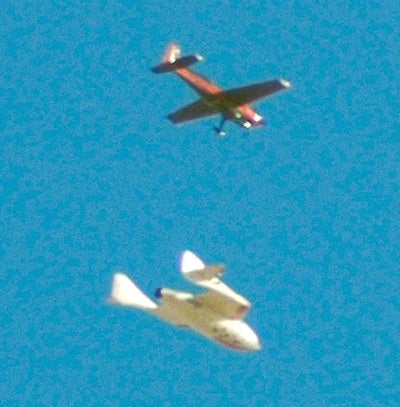
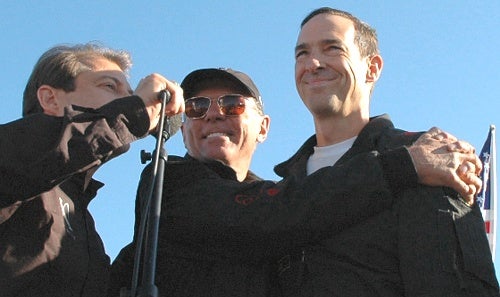
Mike Melvill, the first commercial astronaut, embraces Brian Binnie in the press conference following SpaceShipOne’s prize-winning flight.
Bill McCoy

October 7, 2004
Only three human missions to space were launched from the United States this year, all of them operated by a private company called Mojave Aerospace Ventures (MAV). Monday, the third flight of the group’s SpaceShipOne carried pilot — and now astronaut — Brian Binnie nearly 70 miles into space, winning the group the $10-million Ansari X Prize. The MAV team, which is backed by billionaire Paul Allen and ingenious aerospace designer Burt Rutan, became the first to loft the equivalent weight of three people to an altitude of 62 miles (100 km) twice in 2 weeks.
On June 21, SpaceShipOne became the first privately funded manned spacecraft to reach suborbital space, climbing to an altitude of 328,000 feet (62 miles, or 100 kilometers) and making pilot Mike Melvill the first commercial astronaut. On September 29, Melvill again soared SpaceShipOne to a new height of 337,500 feet (103 km).
Monday’s flight occurred exactly 47 years after the Soviet Union launched the world’s first artificial satellite, Sputnik. Binnie flew SpaceShipOne to 367,442 feet (69.6 miles, or 112 km), clinching the X Prize and soaring 13,000 feet above an unofficial altitude record set in 1963 by the experimental X-15.
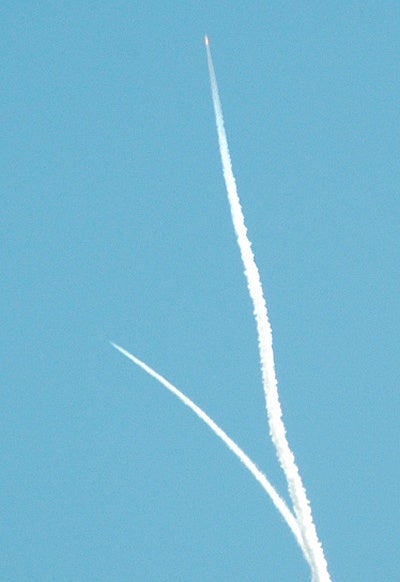
White Knight veered left after dropping SpaceShipOne, which proceeded to rocket into space and the record books during its second X-Prize flight.
Bill McCoy
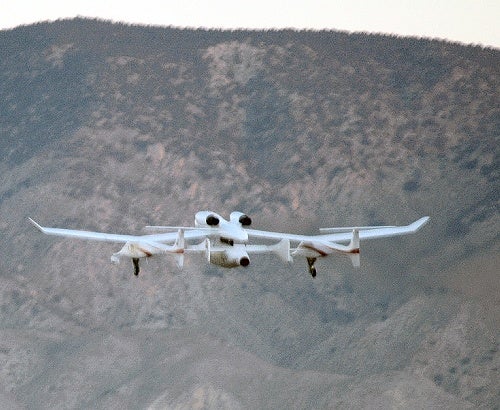
White Knight and SpaceShipOne jet toward the mountains on their launching the winning X-Prize-winning flight October 4, 2004.
Bill McCoy
The end of the beginning
White Knight, the jet that ferried the spacecraft, departed Mojave Spaceport, a civilian aerospace-testing center in Mojave, California, at 6:48 PST, about 20 minutes earlier than the first X-Prize launch September 29. An hour later, White Knight dropped SpaceShipOne, and Binnie, a 51-year-old former U.S. Navy pilot, ignited the craft’s hybrid rocket motor. Ground observers saw two white contrails: White Knight veered left as SpaceShipOne rocketed straight up to suborbital space.
David McNeely and Mike Veno, both of SpaceDev, the company that developed the spacecraft’s rocket, stood together with their colleagues, waving signs reading “Powered by SpaceDev.” “I was standing next to Mike, who was on his radio, listening to the control room from the VIP section,” recalled McNeely. “As soon as I heard him say that Brian tentatively had reached 368 [thousand feet] and was on his way down, passing 350, I knew they had won. It was finally over,” he said, adding, “The beginning, that is.”
Monday was Binnie’s first flight in SpaceShipOne since December 17, 2003. That flight ended with a rough landing and damaged landing gear. After Monday’s flawless flight and landing, Binnie emerged from the craft’s side hatch, where he was met by his wife. Spacecraft designer Burt Rutan, Microsoft cofounder Paul Allen, British entrepreneur Sir Richard Branson, and X-Prize founder Peter Diamandis were also on hand.
At a celebratory post-flight news conference, Diamandis and SpaceShipOne astronaut Melvill held up the American flag Binnie had taken into space with him. “I thank God that I live in a country where this is possible,” Binnie said to the cheering crowd. “The unofficial height was 360 something, but we might have made 370 if my mother-in-law wouldn’t have spilled about a pound of coffee on me this morning,” he joked. “A little accident that added to the drama today.”
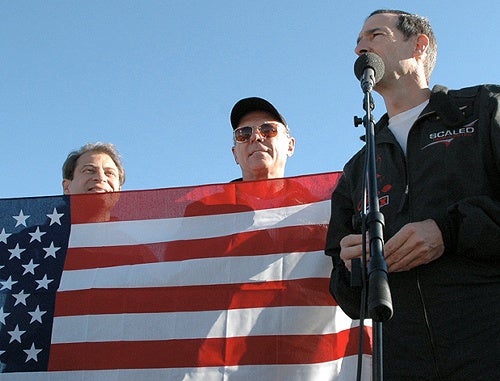
As Brian Binnie speaks at the press conference following his successful flight, X-Prize founder Peter Diamandis (left) and astronaut Mike Melvill (center) unfurl an American flag behind him.
Bill McCoy

A chase plane tags along with SpaceShipOne as it descended from its suborbital flight.
Bill McCoy
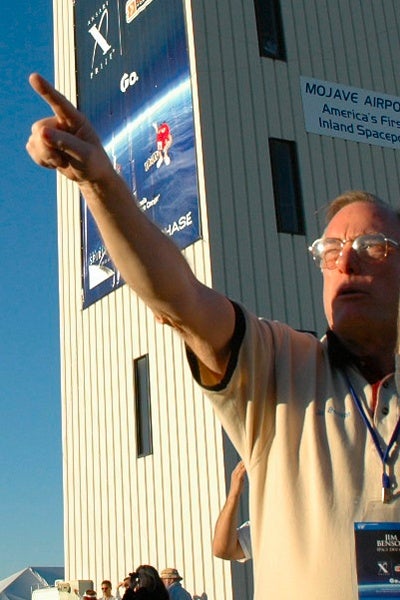
Jim Benson, founder of SpaceDev, Inc., points out SpaceShipOne as the craft ignites his company’s rocket.
Bill McCoy
For all humanity
SpaceShipOne’s successful flights did more than win $10 million — they proved to the world that space is open for all humanity. Space exploration has been under the aegis of government agencies with multi-billion-dollar funding. Prior to SpaceShipOne’s June 2004 flight, only the United States, the Russian Federation, and the People’s Republic of China had sent humans into space.
NASA Administrator Sean O’Keefe congratulated the MAV team in person after the September 29 flight. “This is another important chapter” in the history of manned space flight, he said. “In the end, it’s about that human desire to explore.”
SpaceShipOne and the X Prize have helped launch a new wave of private interest in space flight:
- Sir Richard Branson, chairman of Virgin Group Ltd., announced a licensing agreement with MAV to manufacture multiple spacecraft based on the SpaceShipOne design. The new business, dubbed Virgin Galactic, plans to begin flights as early as 2007. Pricing will start around $200,000 per seat, and the company anticipates having at least 3,000 customers during the first few years.
- Robert Bigelow of Las Vegas-based Bigelow Aerospace is planning to establish America’s Space Prize, a $50-million award for the first orbital vehicle capable of carrying up to seven astronauts to an orbital outpost by decade’s end.
- NASA has announced this year the Centennial Challenges that will manage prizes ranging up to $30 million for commercial space-flight milestones.
- SpaceDev, the Poway, California, firm that developed SpaceShipOne’s rocket motor, is designing a reusable, piloted, suborbital spaceship named Dream Chaser in collaboration with NASA’s Ames Research Center. The spacecraft could be scaled up to transport passengers safely to and from low-Earth orbit, including the International Space Station.
- Zero Gravity Corp., a privately held space-tourism company out of Fort Lauderdale, Florida, offers the experience of weightlessness on flights aboard a modified Boeing 727-200 aircraft. This is the only company to date approved by the FAA to conduct these flights, which are similar to those NASA uses to train astronauts.
- The da Vinci Project, an X-Prize contender funded by Canada’s Golden Palace.com casino, still plans on launching its first private, manned mission. Last week, the team postponed its first flight, originally scheduled for October 2.
With the X Prize won, Peter Diamandis has announced a new competition. The X-Prize Cup will issue awards for altitude, distance, and speed records achieved by the new generation of civilian space companies. He said the first competition would get under way in 2006.
Bill McCoy is a senior programmer in the information technology industry. In his spare time, he consults on web development for companies involved in space exploration. He also volunteers as a telescope operator at Yerkes Observatory in Williams Bay, Wisconsin, supporting the Hands-On Universe program.









